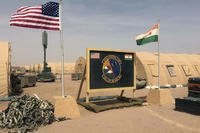The active, Guard and Reserve branches of the Air Force are in a food fight over which units and aircraft would go away in the Austerity Force proposed by this year's budget submission. Who's right? They all are.
Or maybe they're all wrong.
The blue-suiters have found themselves in a numbers battle in which anything can be true or false depending on how you draw the graph. This is necessitated by political problems. The Air Force secretary or chief of staff can't go to Congress and say: I hate the C-27J; I've always hated it; it's antithetical to everything I believe in my blue heart. Lawmakers can say, 'Well, thank you for your opinion, but we're keeping them.' Instead, Big Air Force has to say, "Oh, yikes, this little airlifter is only a 'niche' capability, and it's too expensive, and we can just do what it does with other airplanes just fine.'"
Enter Ohio Air National Guard Capt. Dave Lohrer, who drew up a PowerPoint deck challenging the analysis upon which the Air Force based its decision to ice or sell all of its C-27J Spartans. As our distinguished colleague Mike Hoffman reported Friday, Lohrer's objections were troubling enough that the Air Force convened a roundtable to answer his criticisms for reporters, think-tankists and Hill staffers.
Lohrer’s briefing attacks some of the numbers the service has used in its comparison between the C-27 and C-130, such as the 25-year lifecycle costs. Schwartz cited the C-27J 25-year lifecycle cost at $308 million. He said the C-130J similarly cost the Air Force $213 million and the C-130H $185 million.The Ohio Guardsman argues that the Air Force added 53 more airmen than the C-27J needs to its cost analysis to push the 25-year life-cycle price up an additional $112 million. Lohrer said he found early analysis the Air Force did that dropped the C-27J 25-year lifecycle costs all the way down to $111 million.
Kevin Williams, a retired Air Force colonel who is one of the service’s leading analysts, said Friday he has no idea where Lohrer came up with the $111 million figure.
“It doesn’t exist in any formal authorized signed document. That then becomes the basis of kind of like a math problem when you have the wrong number of the first step of your process and that error ripples through everything else,” said Williams, the deputy director of Air Force Headquarters’ Studies and Analyses, Assessments and Lessons Learned directorate, better known as A9.
Williams also questioned the figure Lohrer used for cost per flying hour. Williams said the service had tabulated each C-27 marginal flying hour to cost $2,700, not $2,100, as Lohrer had written in his briefing.
Everyone's motives here are as plain as day -- the Ohio Guardsmen who fly the C-27J want to keep doing so. The big-airplane blue types in the Building want these little airplanes to go away. The math battle ultimately could just boil down to a contest over whose kung-fu is better.
But Lohrer adds more to the story that the Air Force doesn't like to talk about: The U.S. has spent hundreds of millions of dollars in Afghanistan on contract airlift support, hiring small aircraft for local resupply and other missions. Why, if the Air Force has enough airlift capacity, does it need to spend all the extra money to outsource transport? In fact, Lohrer argues, if DoD used that money to buy more C-27Js, it could accomplish the tasks and own new airplanes ready for a life of service, at a greater long-term value.
One of his last slides compares the Air Force to FedEx, going from "heavy lift/long-haul" capabilities on the left -- the C-5 Galaxy and FedEx's DC-10s -- down to the "short-haul/high efficiency" delivery trucks and twin-engine propeller aircraft on the right. The Air Force's version of that is the C-27J, Lohrer argues; he implicitly makes the case that taking it away would be like taking away FedEx's delivery vans and forcing it to use only its tractor trailers.
Friday's Air Force briefer rejected all this out of hand, as Hoffman wrote:
Williams told a group of reporters and defense analysts Friday that Lohrer and the Ohio Air Guard should have consulted the Air Force before publishing his briefing. “We can’t find anyone in A9 who ever heard from anyone in the Guard about wanting to validate or verify the numbers they were using,” Williams said.
What a surprise.
When all the dust settled, the Air Force was sticking to its guns, and the Guard and its allies continued to question this year's budget decisions. This stalemate could continue for quite a while.








